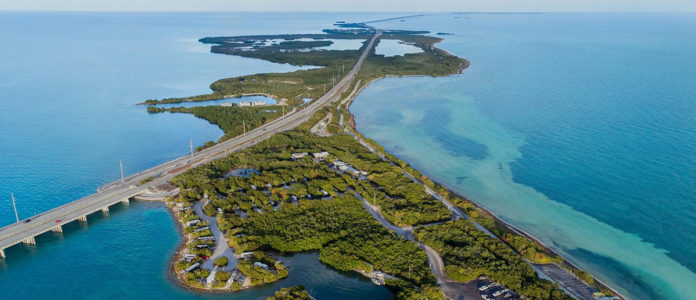
By Anthony Guntert
On July 14, Monroe County held a virtual, public meeting and data driven presentation curated by AECOM regarding the new “Transportation Master Plan” and the future of U.S. 1 throughout the county. The plan includes input from the public, law enforcement and state Department of Transportation officials.
The findings of previous meetings were combined with additional feedback from locals on a myriad of short-term, mid-term and long-term transportation solutions. Possible solutions for roads, signals, signs, and improvements to traffic issues as well as the needs of pedestrians, bicyclists, and public transit were addressed alongside sobering statistics that served to highlight the importance and urgency of the changes needed.
Commissioner David Rice, who chaired the traffic task force for the county, said the findings have implications not just for traffic control, but also for staffing Florida Keys businesses.
“The need to enhance our public transportation system, that’s gonna be a big one,” Rice said. “I think we’re all realizing that we are really hitting close to being out of affordable housing permits, which means we can’t build much more. The obvious alternative is what a lot of other isolated cities have to do, which is build a transportation system that’s comfortable, efficient, and attractive enough to bring (workers) from outside the area.”
Based on the findings of the county task force, the AECOM presentation has provided insight into the wants and needs of the Florida Keys. Monroe County citizens have proposed ideas such as installing overhead safety lighting on dark stretches of highway, more turn lanes, reflectors to separate bike paths from the road, erosion protection for exposed oceanside roads and added signs for extra protection at frequent accident sites. According to public data from the presentation, the widening of U.S. 1 to four lanes seemed to be a popular request from many areas of the Keys public, specifically near Islamorada and the Lower Keys. The presentation outlined a few major goals:
Public transportation
A balanced transportation system would provide space and infrastructure for all means of travel, from buses and cars to bicycles and pedestrians. According to Key West Transit, one of the biggest challenges facing the Keys at the moment is a lack of bus drivers, due both to COVID-19 and and to a general lack of trained drivers with commercial drivers licenses. According to the task force, about 900 passengers per day ride the Miami-Dade-Keys bus to and from their jobs in the Keys. The presenters noted that while the Florida Job Fund is providing training and incentives are being drafted to recruit more drivers, more still needs to be done. Other additional strategies for improving public transportation include using smartphone apps for bus routes that include mapping, and the ability to request pickup at a bus stop. Extending Route 301 to the southern end of Marathon was also mentioned.
Traffic safety
The task force identified “hot spots” of accident clusters and suggested improved signs in problem areas. In the Keys, vehicular accidents tend to be clustered around certain sites where any combination of factors, from insufficient signs to blind turns, can be deadly. According to the data, the most dangerous part of U.S. 1 in the last six years is the 38-mile stretch from the Miami-Dade county line to Caloosa Cove: 2,666 crashes, 24 of them fatal. The Monroe County Sheriff’s Office sent in its own safety recommendations, including adding street lights near bus stops, extra signal lights at critical intersections and putting in additional signs at the most common accident sites throughout the Keys. The task force also addressed causes of traffic congestion, citing areas of the Keys that are currently served by only two lanes and intersections whose signals need refining, such as Islamorada. Suggestions included working with the DOT to analyze the flow of traffic in order to add additional turn & acceleration lanes, roundabouts and frontage roads.
Tourist-friendly roads
A key finding of the task force addressed the importance of preserving the Keys’ “Scenic Byway” by introducing enhanced environmental protections for wildlife and defenses against natural events such as hurricanes and storm surges. One of the suggestions is to create pull-over rest areas where visitors can take in the view, without slowing down traffic. Additionally, the completion of our Overseas Heritage Trail has been popular with both visitors and locals alike.
Funding
The task force also discussed a myriad of funding possibilities with two major ideas leading the pack. One, implement a one-cent transportation sales tax while creating a Florida Keys Transit Authority in the style of Aspen, Colorado that would likely require the cities to work with the county directly; or, two, join the South Florida Regional Transport Authority and extend their already established system down to us.
The Monroe County Commission will hear the findings at its October meeting and deliberate next steps.
- Most fatal accidents in the Keys are due to head-on collisions.
- Most commonly requested improvement: Adding additional signage and restrictions at places like intersections, pull-outs and community entrances
- Most proposed form of infrastructure updates by officials: bridge repair and road resurfacing
























